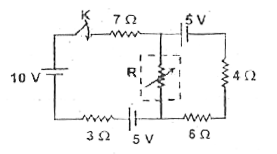A hot fbody placed in air is cooled down according to Newton's law of cooling, the rate of decrease of temperature being k times the temperature difference from the surrounding. Starting from , find the time in which the body will loss half the maximum heat it can lose.
We have
. Where . Is the temperature of the surrounding and theta his the temperature of the body at time t. Suppose at t=0 .
Then, .or, (theta-theta_(0))/(theta_(1)-theta_(0))=-kttheta-theta_(0)=(theta_(1)-theta_(0))e-^(kt)DeltaQ_(m)=ms(theta_(1)-theta_(0))(DeltaQ_(m))/(2ms)=(theta_(1)-theta_(0))/(2) . will be
. Putting these values of time and temperature in (i),
. or, . or, .
Topper's Solved these Questions
- BOOK - HC VERMACHAPTER - HEAT TRANSFEREXERCISE - Short Answer11videos
HEAT TRANSFER
- BOOK - HC VERMACHAPTER - HEAT TRANSFEREXERCISE - Objective 110videos
HEAT TRANSFER
- BOOK - HC VERMACHAPTER - HEAT TRANSFEREXERCISE - EXERCIESE1videos
HEAT TRANSFER
- BOOK - HC VERMACHAPTER - HEAT AND TEMPERATUREEXERCISE - Exercise4videos
HEAT AND TEMPERATURE
- BOOK - HC VERMACHAPTER - INTRODUCTION TO PHYSICSEXERCISE - Exercises19videos
INTRODUCTION TO PHYSICS
Similar Questions
A hot body placed in air is cooled down according to newton's law of cooling the rate of decrease of temperature being k times the temperature difference from the surrounnding Starting from t=0 The time in which the body will lose half of the maximum heat is xLn22k Find the value of x .
View SolutionIn the circuit shown the resistance R is kept in a chamber whose temperature. is 20∘C which remains constant. The initial temperature and resistance of R is 50∘C and 15Ωrespectively. The rate of change of resistance R with temperature is 12Ω/∘C and the rate of decrease of temperature of R is In(3/100) times the temperature difference from the surrounding (Assume the resistance R loses heat only in accordance with Newton's law of cooling) If K is closed at t = 0, then find the
(a) value of. R for which power dissipation in it is maximum.
(b) temperature of R when power dissipation is maximum
(c) time after which the power dissipation will be maximum
 View Solution
View Solution
Knowledge Check
- Question 1 - Select One
According to Newton's law of cooling, the body cools from 100∘C→60∘C in 20 minutes. The temperature of the surrounding being 20∘C The body cool down to 30∘C in
A40 minutesB50 minutesC90 minutesD60 minutes - Question 2 - Select One
According to Newton's law of cooling, the body cools from 80∘Cand50∘C at room temperature of 25∘C in 30 minutes. After 1 hours, the temperature of the body is
A11.36∘CB18.18∘CC36.36∘CD22.72∘C - Question 3 - Select One
According to Newton’s law of cooling, the rate of cooling of a body is proportional to (Δθ)n , where Δθis the difference of the temperature of the body and the surrounding, and n is equal to :
AOneBtwoCthreeDfour
A hot body placed in a surrounding of temperature θ0 obeys Newton's law of cooling dθdt=−k(θ−θ0) . Its temperature at t=0 is θ1 the specific heat capacity of the body is s and its mass is m. Find (a) the maximum heat that the body can lose and (b) the time starting from t=0 in which it will lose 90% of this maximum heat.
View SolutionAccording to Newton's law of cooling, the rate of cooling of a body is proportional to (Δθ)n, where Δθ is the difference of the temperature of the body and the surroundings, and n is equal to
View SolutionAccording to Newton's law of cooling, the rate of cooling of a body is proportional to (Δθ)n, where Δθ is the difference of the temperature of the body and the surroundings, and n is equal to
View SolutionIf the system were lossing heat according to Newton's cooling law the temperature of the mixture would change with time according to (while heater was on) .
View SolutionA body is heated to a temperature of 75∘C and is allowed to cool. If the temperature of the surrounding is 35∘C, then the temperature at which the rate of cooling will be exactly half of that initially will be
View Solution

